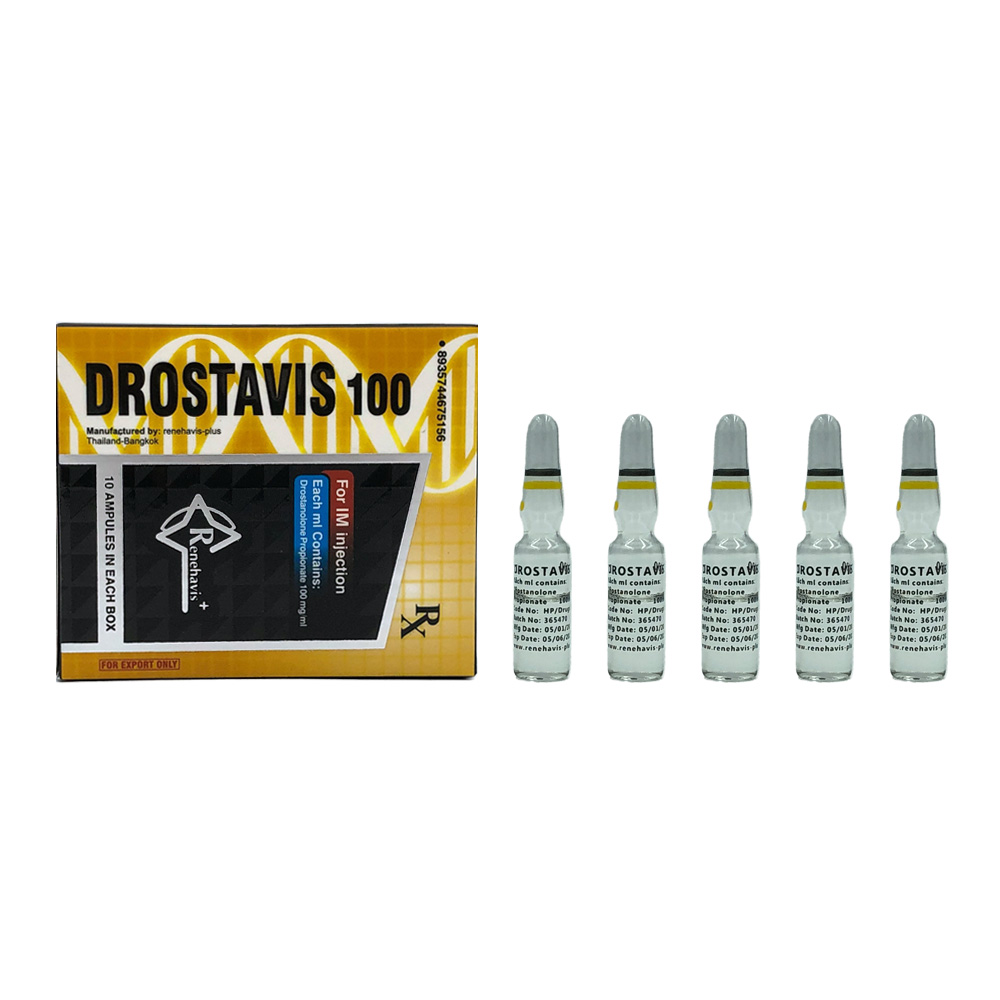
DESCRIPTION
DROSTAVIS 100 is a synthetic derivative of
dihydrotestosterone, producing an anabolic
effect and promoting protein synthesis as well as creating
positive nitrogen balance in
humans. Since it is a derivative of dihydrotestosterone,
drostanolone does not aromatize to
estrogens. DROSTAVIS 100 and Drostan 150 have significant
anabolic and androgenic
properties promoting an increase in strength and growth of
muscle tissue while acting as an
estrogen antagonist. The combination of a short-acting
propionate ester with a long-acting
enanthate ester produces rapid increases in serum
drostanolone levels with a sustained
duration of 5-8 days.
CLINICAL PHARMACOLOGY
Anabolic steroids are synthetic derivatives of testosterone.
Certain clinical effects and
adverse reactions demonstrate the androgenic properties of
these drugs. Complete
dissociation of anabolic and androgenic effects has not been
achieved. The actions of
anabolic steroids are thus similar to those of male sex
hormones. Anabolic steroids
suppress the gonadotropic functions of the pituitary and may
exert a direct effect upon the
testes. During exogenous administration of anabolic
androgens, endogenous testosterone
release is inhibited through inhibition of pituitary
luteinizing hormone (LH). At large doses,
spermatogenesis may be suppressed through feedback
inhibition of pituitary folliclestimulating hormone (FSH).
Drostanolone attaches to androgen receptors; increasing
nitrogen retention and protein
synthesis. Drostanolone acts on DHT modulated pathways as
well. Drostanolone is a potent
estrogen antagonist and does not aromatize to estrogen,
limiting expression of side effects
often linked to estrogen such as water retention,
gynecomastia, and some types of high
blood pressure. Drostanolone undergoes hepatic metabolism
with a half-life of 2-3 days
after separation of the ester.
INDICATIONS
To rapidly restore muscle tissue atrophied during recovery
from a traumatic injury.
To offset muscle catabolism in patients with a wasting
syndrome.
To treat certain types of anemia which are non-responsive to
first line agents.
Oestrogen antagonist in treatment of breast cancer.
CONTRAINDICATIONS
Not indicated for women, children, or the elderly.
Women who are pregnant or may become pregnant because of
possible masculinization of
the fetus.
Patients with nephrosis or the nephrotic phase of nephritis.
Patients with hypercalcemia.
Patients suffering from testicular cancer, prostate cancer,
breast cancer, liver damage,
kidney damage, stroke, high blood pressure, heart disease or
respiratory problems.
PRECAUTIONS
Elevated liver enzymes and in rare cases hepatic liver
dysfunction may occur. Periodic liver
function should be monitored for changes including serum
bilirubin, AST, ALT, and AP.
Edema may be increased in patients on concurrent adrenal
cortical steroid or ACTH therapy.
Anabolic steroid hormones may increase low-density
lipoproteins (LDL) and decrease high
density lipoproteins (HDL).Lipids levels generally return to
normal upon discontinuation of
treatment.
Anabolic steroids may reduce clotting factors II, V, VII,
and X, and may increase prothrombin time (PT). Patients should be instructed to
report any use of warfarin and any
irregular bleeding.
ADVERSE REACTIONS
Male: Gynecomastia, excessive frequency and duration of
penile erections, oligospermia.
Skin and Appendages: Hirsutism, male pattern baldness and
acne, gynecomastia.
Fluid/electrolyte Disturbances: Retention of sodium,
chloride, water, potassium, calcium,
and inorganic phosphates.
Gastrointestinal: Nausea, cholestatic jaundice, alterations
in liver function tests; rarely,
hepatocellular neoplasms, peliosis hepatitis, hepatic
adenomas, and cholestatic hepatitis.
Hematologic: Suppression of clotting factors II, V, VII,
& X; bleeding in patients on anticoagulant therapy.
Nervous System: Changes in libido, aggression, headache,
anxiety, depression, and
generalized paresthesia.
Metabolic: reduced glucose tolerance, increased creatinine
clearance, and inhibition of
gonadotrophin secretion.
Other: Serum lipid changes, hypercalcaemia, hypertension,
oedema, priapism, and
potentiation of sleep apnea.
PATIENT MONITORING
Serum Cholesterol, HDL, LDL, TG. Hemoglobin and Hematocrit,
Hepatic function tests –
AST/ALT
Prostatic specific antigen – PSA, Testosterone: total, free,
and bioavailable.
Dihydrotestosterone & Estradiol
Male patients over 40 should undergo a digital rectal
examination and evaluate PSA prior to
androgen use.
Periodic evaluations of the prostate should continue while
on androgen therapy, especially in
patients with difficulty
in urination or with changes in voiding habits.
DOSAGE AND ADMINISTRATION
Adult male: 100 – 150mg injected IM every 3-5 days for
duration of 4-8 weeks.
PRESENTATION
DROSTAVIS 100 (100mg/ml) – 10 ampules of 1ml each
| COMPOSITION | |
| Each ml contains: | |
| Drostanolone Propionate | 100 mg |